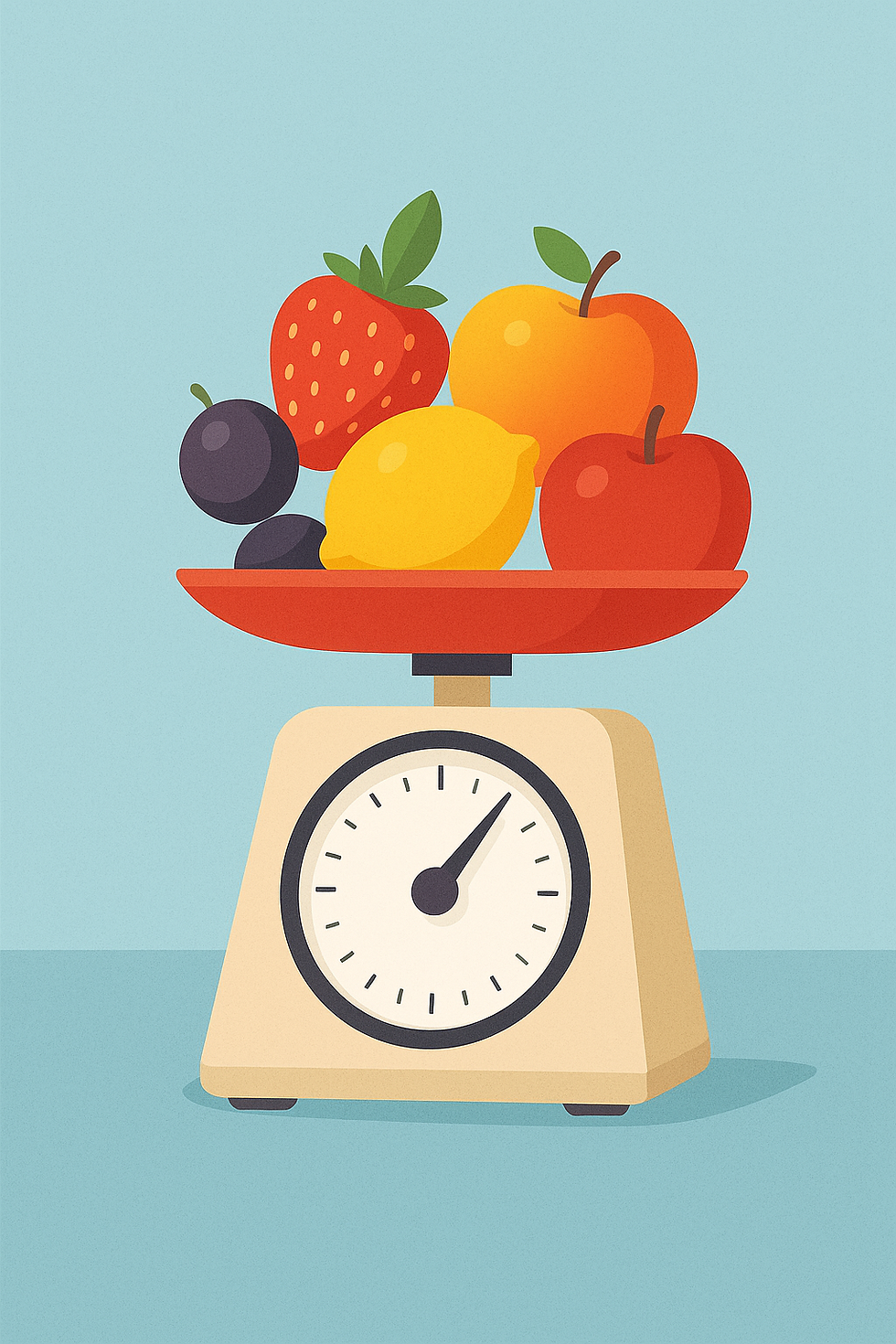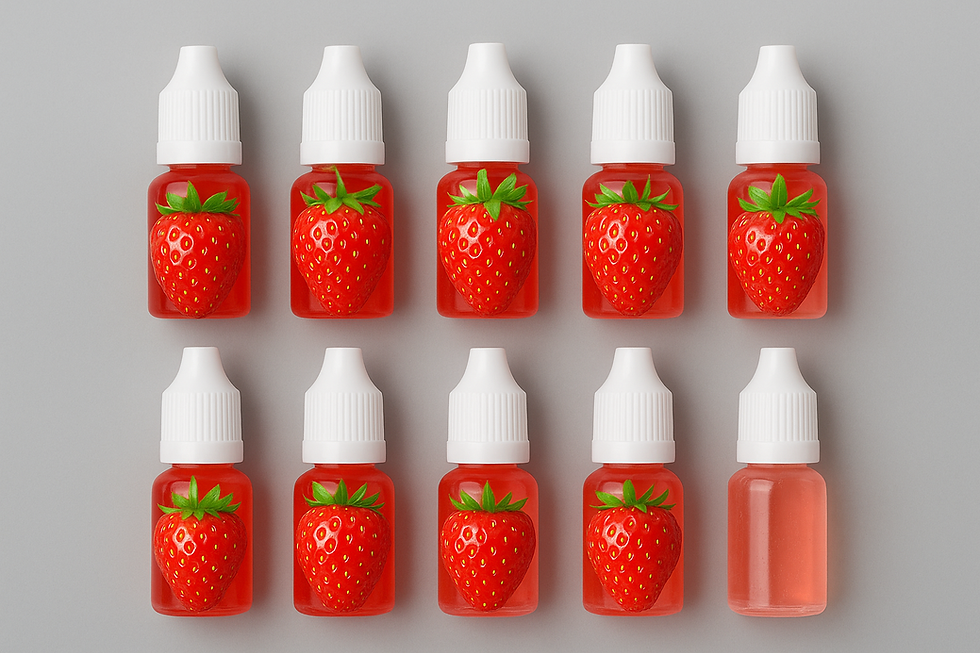What Flavours to Buy for Your First Order: A Beginner’s Guide
- Taste Nest

- Aug 20
- 6 min read
Updated: Nov 12
🌱 Introduction: Where to Begin?
Imagine creating your own signature strawberry cheesecake ice cream or a rich and yummy pistachio gelato. How about a fancy lemon-flavoured craft beer or a new soda flavour that goes viral and blows the same old drinks out of the water? These amazing creations are all achievable when you start mixing and matching flavours correctly.
When you first step into the world of food flavour concentrates, bringing those ideas to life can feel overwhelming. There are hundreds of flavours available—fruits, desserts, bakery notes, beverages, and even exotic spices. Choosing your first order is often the hardest part.
Do you start with the flavours you personally love, like strawberry or mango? Or do you buy a wide variety and test everything at once? The truth is, buying too many flavours at the beginning can be expensive and frustrating. Many of them might end up sitting unused in the back of a cupboard because they don’t suit your recipes or don’t blend well with others.
That’s why I recommend starting with a small, carefully chosen set of flavours. This starter blog will let you experiment, create simple recipes, and learn the basics of mixing and matching flavours—without overspending or getting lost in endless options. Once you have a foundation, you can expand into more complex flavours like cheesecakes, cookies, or tropical blends.
The flavours below are chosen because they’re bold, versatile, and easy to work with, making them perfect for beginners.
👉 Important note: Taste is subjective. The best way to discover what suits you is to try and test recipes yourself. This guide gives you a strong foundation, but the final balance will always depend on your own palate.
🍎 Step 1: Start with Fruits
Fruit flavours are the best entry point for beginners. They are straightforward, instantly recognisable, and very flexible. If you make a strawberry-flavoured ice cream, almost anyone tasting it will immediately know what it’s meant to be. Fruits also mix well with each other—you can combine two or three and quickly discover delicious new combinations.
Here are some of the most useful fruits to start with:
Flavour Art Fuji: Crisp, juicy, and fresh. Fuji Apple is often called the best apple flavour because it tastes so natural. You can use it alone, pair it with other fruits, or add it to a bakery base like pie or strudel later on.
Flavour Jungle Ultimate Strawberry: Strawberry is one of the most used flavours in food and beverage recipes. This version is bold, sweet, and reliable—it works in ice creams, drinks, cakes, or even as a simple strawberry milk base.
Flavour Express: Mango is tropical, juicy, and instantly recognisable. Both these brands deliver a solid mango flavour that can stand on its own or mix beautifully with cream or peach.
Duomei Grape: Grape is fun, bright, and very easy for beginners. It’s one of those flavours where even a small amount can transform a recipe into something bold and punchy.
Flavour West Blueberry: Blueberry is versatile but can be tricky depending on the brand. Flavour West’s version is bold enough for a beginner to recognise and use effectively. Later, you can experiment with softer or more complex blueberries.
Flavour Art Lemon Sicily: Lemon is a must-have because it acts like a “brightener.” Even a few drops can lift a dull recipe, add freshness, and balance sweetness.
TFA Banana Cream: Banana adds a creamy, dessert-like quality. Unlike sharper fruits, it blends well with bakery and custard flavours, making it a bridge between fruity and dessert recipes.
Flavour Art White Peach: Peach is soft and juicy, with a natural sweetness that pairs beautifully with berries and creams. TFA Juicy Peach or Flavor Jungle Honey Peach are sold peach flavours.
Capella Sweet Tangerine: A sweet, citrusy fruit that’s fresh and uplifting, perfect for drinks and candy-like profiles. Also, FA Mandarin is a solid mandarin.
👉 Once you’ve picked up a few of these fruits, you already have a wide palette for mixing: strawberry + banana for smoothies, mango + peach for a tropical vibe, or lemon + blueberry for a zesty dessert base.
🥛 Step 2: Add Creams for Body and Mouthfeel
If you only mix fruits, your recipes might taste bright but flat or “thin.” This is where cream flavours come in. Cream doesn’t just add flavour—it gives recipes depth, richness, and smoothness, the same way whipped cream or milk changes the texture of real food.
TFA Bavarian Cream: This is a darker cream with bakery undertones, like the filling inside a pastry. It works well with bananas, berries, and desserts.
Flavour Art Fresh Cream: A lighter, simpler cream that doesn’t overpower the fruit. It gives a smooth background without changing the main profile too much.
⚠️ Creams are powerful and can take time to show their full effect. Start with less than 1%. At first, you might not even notice the cream, but after a few days of letting your recipe sit, the cream note will blend in and create that soft, full-bodied mouthfeel.
🍦 Step 3: Using Ice Cream Bases
Instead of cream, you can also use ice cream flavours. These don’t instantly make a complete ice cream on their own—they act as a base to give recipes more thickness and creaminess.
Liquid Barn Vanilla Ice Cream is one of the most reliable. At around 4%, it provides a creamy foundation that you can build on with fruits, chocolate, or bakery notes.
TFA Vanilla Bean Ice Cream is another option, though some people notice a peppery taste depending on how they perceive it.
Ice cream bases are especially good if you’re making fruity desserts, shakes, or candy-like recipes.
❄️ Step 4: Cooling Agents
Even if you don’t think you like cooling effects, it’s worth testing one. Cooling agents don’t add mint or menthol taste—they add a chilled sensation, similar to the refreshing feel of an iced drink.
The most common option is WS-23. Used under 1%, it gives a refreshing layer to your recipe. At very low levels (around 0.25%), it can even act as a “mouthfeel” enhancer, making flavours feel smoother and more complete.
This is optional, but many beginners find it surprisingly useful once they try it.
🍭 Step 5: Sweeteners
One thing beginners often overlook is that flavour concentrates are usually not sweetened. If you use them on their own, the result might taste flat or even slightly bitter. Adding a sweetener balances everything out and makes recipes taste more realistic.
The most recommended option is Capella Super Sweet. It’s simple to use and very effective. Just remember: this sweetener is only for your concentrate recipes. If you’re baking a cake, for example, you still need to sweeten the cake itself separately.
🍪 Step 6: Bakery and Dessert Flavours
Once you’ve mastered fruits and creams, it’s time to expand into bakery and dessert flavours. These give you access to cheesecakes, pies, cookies, and custards—the building blocks of more advanced recipes.
A great place to start is Capella Vanilla Custard. It’s flexible:
At 1–2%, it can sit in the background, adding creaminess.
At 6–10%, it becomes the main flavour, rich and custardy.
One important note: custards and bakery flavours often need time to develop. Vanilla Custard, for example, usually takes 3–4 weeks of “steeping” before it reaches its full potential. Patience is key!
Other bakery flavours to consider later on: lemon meringue pie, cheesecake, sugar cookie, cinnamon Danish swirl, and meringue.
🧪 How to Start Matching Flavours
Now that you have your starter flavours, the question is: how do you begin?
Start with single flavours: Try making a simple strawberry soda, mango mocktail, or banana milk base. This teaches you how each flavour tastes on its own.
Layer slowly: Add cream, custard, or ice cream to a fruit and see how it changes the body.
Experiment with two fruits: Strawberry + banana, mango + peach, or blueberry + lemon are great pairings.
Play with cooling and sweetness: Try the same recipe with and without WS-23 or Super Sweet and compare.
Keep notes: Write down what percentages you used, how it tasted fresh, and how it developed after a few days. This record is your roadmap for improvement.
👉 The most important rule: keep your first batches small. It’s better to make 20ml and discover it’s not for you than waste a large amount of ingredients.
📦 Example Beginner’s First Order
Here’s a balanced shopping list to start with:
Fruits: Apple, Strawberry, Mango, Grape, Blueberry, Lemon, Peach, Banana
Cream: Bavarian Cream or Fresh Cream
Ice Cream Base: Vanilla Ice Cream
Cooling Agent: WS-23
Sweetener: Capella Super Sweet
Bakery Base: Vanilla Custard
With just these flavours, you can already create dozens of recipes:
🍓 Strawberry + Cream + Vanilla Ice Cream = Strawberry Milkshake
🥭 Mango + Peach + WS-23 = Tropical Icy Blend
🫐 Blueberry + Lemon + Custard = Blueberry Lemon Pie
🍌 Banana + Bavarian Cream = Banana Cream Dessert
🌟 Final Thoughts
Getting started with food flavour concentrates doesn’t have to be confusing. By focusing on a compact starter set of fruits, creams, and a few enhancers, you’ll learn faster, save money, and actually enjoy the process.
From fruity ice creams to flavoured drinks, bakery-style desserts, and refreshing mocktails—the possibilities are endless once you understand how flavours interact. Start simple, experiment in small batches, and most importantly—trust your taste buds.
Your first order is just the beginning of a flavour journey that could stay as a fun hobby—or grow into a serious passion or even a business.
---wix---





Comments